
Cyber Security Critical for Business
August 15, 2018
Investing in Our Futures
August 15, 2018In South Louisiana, residents are highly vulnerable to water damage not just during hurricane season but also throughout the entire year. However, there are preemptive and post-measures that help lessen the blow caused by not only water but fire and mold damage as well.
Although precautions won’t stop a natural disaster from happening, it can help the recovery process, especially with finances. Expert in the environmental mitigation field, Marty Boquet is the owner of Houma’s Enviro-Clean Services Inc.–a company that specializes in 24/7 emergency response and restoration services that can handle aspects of mold, water and fire damage restoration and cleanup. He suggests not only taking inventory by recording video of your entire house before an imminent hurricane, but also on a more consistent basis in case of another disaster such as a fire were to strike your home.
“It makes the process with your homeowner’s insurance a lot easier if they know that what’s called the pre-loss condition [describes the condition of residence or vehicle prior to damage],” Boquet says.
If a resident lives in a two-story home, he also highly recommends getting the most expensive items upstairs if faced with the possibility of a flood.
For fires, Boquet says cooking accidents, candles and electrical malfunctions are the three most common causes his company sees, the latter caused mainly by nightlights.
“Believe it or not, the majority of the electrical fires that we see are nightlights that get left on all night long. They’ll short out or start a little spark, and then next thing you know, you got a fire on the carpet underneath it,” he explains.

Boquet also encourages having a smoke alarm in every room.
“If something’s going to happen, you might as well know about it and not let it travel to another room before you hear an alarm go off,” he says. “The sooner you can get to it and react to it, lives will be saved. The structure will be less impacted.”
Although there are proactive measures to take in case of a flood or fire, mold mitigation is probably where a homeowner can be most effective when being proactive. Typically, mold forms within 72 hours from when water is introduced to porous materials. However, people can stop the start or expansion of mold if they handle their water damage early.
“You have a spot on wall that’s the size of a small dinner plate because you had a leak in a window or a leak from the attic, and you don’t address it. Two years from now, it turns into black mold,” Boquet explains. “Homeowners let a $500 fix turn into a $5,000 project.”
Mold can form after flooding, pipe leaks or oversized air-conditioning systems in which short cycling leaves humidity in the air causing the mold to form.
“We’ve been in homes, not exaggerating, where all of the ceilings in the entire home are black from mold, and it looks like a rain forest in the home because the air conditions are short cycling and not pulling the humidity out of the air,” Boquet says.
After a flood, it is important to get the walls open and wet materials (couches, rugs, etc.) out and opened because the quicker the drying process starts the more that is able to be salvaged. Because the waters after flooding are “category three” contaminated waters, it is also important to seek a professional cleaning service like Enviro-Clean who have the proper disinfecting chemicals to prevent illness from the contaminated materials.
“We have a very thorough disinfecting process that we use here. When homes are flooded, they are very thoroughly disinfected and cleaned,” says Boquet. “The solutions that we use mitigate bacterial, fungal, viral and all of the other contaminants that would be detrimental to somebody’s health.” •







